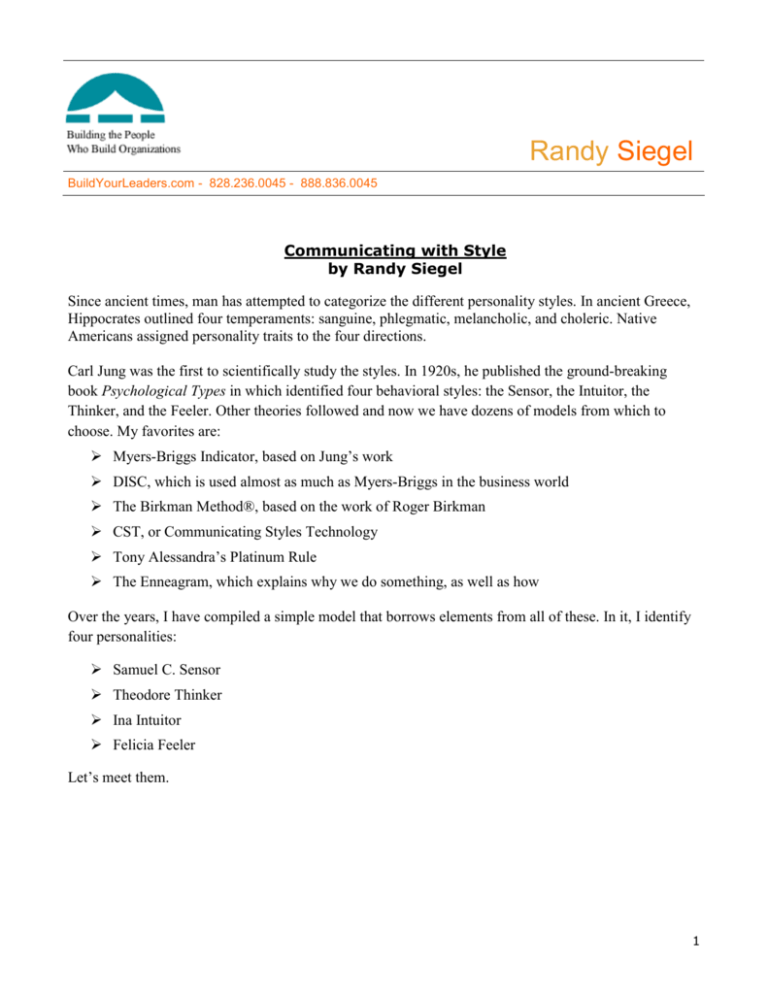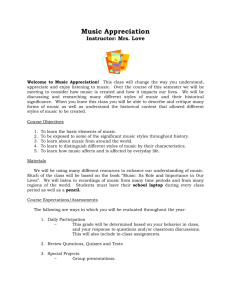
Randy Siegel
BuildYourLeaders.com - 828.236.0045 - 888.836.0045
Communicating with Style
by Randy Siegel
Since ancient times, man has attempted to categorize the different personality styles. In ancient Greece,
Hippocrates outlined four temperaments: sanguine, phlegmatic, melancholic, and choleric. Native
Americans assigned personality traits to the four directions.
Carl Jung was the first to scientifically study the styles. In 1920s, he published the ground-breaking
book Psychological Types in which identified four behavioral styles: the Sensor, the Intuitor, the
Thinker, and the Feeler. Other theories followed and now we have dozens of models from which to
choose. My favorites are:
¾ Myers-Briggs Indicator, based on Jung’s work
¾ DISC, which is used almost as much as Myers-Briggs in the business world
¾ The Birkman Method®, based on the work of Roger Birkman
¾ CST, or Communicating Styles Technology
¾ Tony Alessandra’s Platinum Rule
¾ The Enneagram, which explains why we do something, as well as how
Over the years, I have compiled a simple model that borrows elements from all of these. In it, I identify
four personalities:
¾ Samuel C. Sensor
¾ Theodore Thinker
¾ Ina Intuitor
¾ Felicia Feeler
Let’s meet them.
1
Exercise: Who am I?
Instructions: Which style--Samuel C. Sensor, Ina Intuitor, Theodore Thinker, or Felicia Feeler--matches
which set of traits?
Style
Positive Traits
Negative Traits
Spontaneous
Impulsive
Persuasive
Manipulative
Empathetic
Over-personalizes
Probing
Sentimental
Introspective
Postponing
Draws out feelings of others
Guilt-ridden
Loyal
Stirs up conflict
Subjective
Accurate communicator
Verbose
Deliberative
Indecisive
Prudent
Overly cautious
Weighs alternatives
Over-analyzes
Stabilizing
Unemotional
Objective
Controlling
Rational
Analytical
Pragmatic
Status-seeking
Assertive, directional
Acts first, then thinks
Results-oriented
Lacks trust in others
Bases opinions on what he
actually sees
Nit-picking
Self-involved
Perfection seeking
Original
Unrealistic
Imaginative
Fantasy-bound
Creative
Scattered
Broad-gauged
Devious
Charismatic
Out-of-touch
Idealistic
Impractical
Ideological
2
Meet the Styles
In reviewing this information, it is helpful to keep in mind:
¾ No one style is better than another. Each brings a unique set of skills into the workplace.
¾ Most assessments are based upon self-assessment, and as such are subject to bias.
¾ You have elements of each of the four styles in you, but usually one style guides your behavior
most of the time. Don’t expect one style to totally nail your personality. If it’s sixty percent or
more on target, then it’s probably your style.
¾ Your style most likely changes under stress. I go from Samuel to Theodore when I feel
pressured.
This table will further summarize individual characteristics and communications preferences for each
style. As you review each style, see if you can pick out your own. How about someone whom you work
with?
Samuel C. Sensor
Areas
Characteristics
Environment
Expresses “status,” formal, stiff,
somewhat impersonal
Appearance
Formal, loves labels for special
occasions. Can be informal, simple,
and functional at other times
Demeanor
Impersonal, hurried, impatient, high
energy, physically restless, and
assertive
Strengths
Administration and leadership
Can be seen as
Unable to see long-range or big
picture, impatient and impulsive
Values/Hot Points
Action, goals, results, wealth, and
winning
Goals
Save time, increase productivity
Wants
Control
Biggest Fear
Being taken advantage of
Irritation
Indecision
3
Under Stress
Dictatorial, insensitive, and
impatient
Other Characteristics:
Compartmentalized
Lives in here and now
Tough negotiator
Good at multitasking
Learns by doing
Communications Preferences
For decisions needs
Facts, top-line
Requires you to be
To-the-point, “What can you do for
me today?”
Pace
Fast
Level of detail
Top-line
On phone
Succinct
Written word
Bulleted, provide executive summary
Orally
Speaks with conviction
Other Tips:
Confront and challenge.
Schedule early meetings.
Offer choices.
Avoid detail.
Theodore Thinker
Areas
Characteristics
Environment
Expresses “efficiency,” tasteful but
conventional
Appearance
Formal, functional, conservative,
color coordinated but not colorful,
understated
Demeanor
Impersonal, hard to read, thoughtful,
and sometimes considered “dry” or
“cold”
Strengths
Planning, problem solving, thinker
and doer
Can be seen as
Perfectionist and critical
4
Values/Hot Points
Precision, process, procedure – safe
choice, ethics
Goals
Justification
Wants
Thoroughness
Biggest Fear
Being embarrassed
Irritation
Unpredictability
Under Stress
Withdrawn, overly cautious (to the
point of not being able to make
decisions)
Other Characteristics:
Resists pressure of any kind
Expects you to take initiative
Reluctant to give any feedback
Communications Preferences
For decisions needs
Data and documentation
Requires you to be
Detailed, thorough, accurate
Pace
Slow (allow time to think), systematic
Level of detail
Heavy
On phone
Organized, sounds ordered,
measured, businesslike, and careful
Written word
Detailed, well-organized, structured,
and specific
Orally
Needs time to think
Other Tips:
Plan each meeting carefully.
Avoid social talk.
Present obvious disadvantages.
Felicia Feeler
Areas
Characteristics
Environment
Friendly, comfortable, “homey”
Appearance
Informal, may “costume,” dresses
for mood more than approval
5
Demeanor
Friendly, warm
Strengths
Listening and teamwork (often
responsible for grapevine)
Can be seen as
Oversensitive and indecisive
Values/Hot Points
Acceptance, feelings, trust, and
teamwork
Goals
Stability
Wants
Friendships
Biggest Fear
Sudden change and conflict
Irritation
Insensitivity
Under Stress
Submissive, moody, not concerned
with details
Other Characteristics:
Works off of “gut” feelings a lot
Can be spontaneous and
unstructured
Seen as perceptive and insightful
Patient
Communications Preferences
For decisions needs
Personal service and assurances
Requires you to be
Warm
Pace
Slow, relaxed, low pressure
Level of detail
Heavy
On phone
Friendly, chatty
Written word
Warm, short, and highly
personalized
Orally
Warm
Other Tips:
Express enthusiasm; tell why
personally important to you.
Allow them to get to know you.
Schedule meetings around meals.
Customize program/individualized
approach.
Use open-ended questions to draw
them out and build trust.
6
Ina Intuitor
Areas
Characteristics
Environment
“Fun,” messy, futuristic
Appearance
Unpredictable, could be fashion
forward, flashy, or like “absentminded professor”
Demeanor
Charismatic
Strengths
Brainstorming and sales
Can be seen as
Scattered, careless, lack of details,
“long on vision, short on action”
Values/Hot Points
Big ideas and high energy
Goals
Recognition
Wants
Others’ approval
Biggest Fear
Loss of prestige
Irritation
Routine
Under Stress
Sarcastic, impulsive, can become
detached
Other Characteristics:
Sees big picture; long-term
implications
Hates to feel “hemmed in”
Communications Preferences
For decisions needs
How it addresses status/visibility
Requires you to be
Enthusiastic
Pace
Fast
Level of detail
Light
On phone
Playful (jokester)
Written word
Bulleted, writes abstractly
Orally
Dramatic
7
Other Tips:
Offer testimonials and incentives.
Allow lots of time for interaction.
Let him/her set the pace.
Balance information with stories.
Involve as many senses as possible.
Save them effort.
Involve them in idea generation.
Focus on concepts, not on details.
Have fun!
Hopefully, you now have a feel for each of the communications styles and what makes their socks go up
and down. Did you see yourself? How about someone with whom you work?
Most of us go through life communicating with people in ways we like them to communicate with us.
For example, I am a Samuel C. Sensor, so my natural tendency is to be on-point and to-the-point.
Seldom would I ask personal questions; it takes too much time. When I am dealing with a Felicia or Ina,
however, I must flex styles to take the time to build a relationship before launching into the business at
hand. When I am communicating with a Theodore, I delve into a lot more detail than I would normally,
and if I am really on, I might throw in a process or procedure for good measure.
I am not being inauthentic when I flex styles. As mentioned earlier, each of us has a little of the four
styles within us. I am simply making a conscious effort to intensify the style that matches that of the
person with whom I am communicating. My intention is never to manipulate, but to connect. By flexing
my style, I am only fertilizing the soil so that communication and connection can grow.
It’s important to note that this handout is only intended to provide a brief overview of the four
communications styles. This topic is worthy of a book unto itself. In the back you’ll find a reading list
for more information. I especially recommend The Platinum Rule by Tony Alesandra and Michael J.
O’Connor which inspired much of my model.
###
"The Career Engineer" Randy Siegel helps organizations foster dynamic leaders who make rain, close
deals, motivate employees, and are more positive and productive at both work and home. His
proprietary process facilitates self-discovery to clarify personal perspective, true purpose, and
professional image. This engaging process transforms high-potential employees into highly motivated
and effective leaders who are committed to their organizations and careers. Additionally, it helps
presidents and CEOs become more charismatic leaders, spokespeople, and ambassadors for the
organizations they serve.
As a result of Randy's work, organizations can expect to:
¾ Develop a continuing stream of new leaders and managers
¾ Recruit and retain "superstars"
¾ Win more business through stronger sales presentations
¾ Project a more positive image for the organization through its leadership
8
His clients include such industry leaders as Coca-Cola Enterprises, Earthlink, the Dallas Museum of Art,
The Recording Academy (The Grammy Awards), State Farm Insurance, Grove Park Inn Resort & Spa,
The Community Foundation for Greater Atlanta, Cox Communications, the University of Georgia's
MBA Program, Viking Range Company, and The Giving Institute.
Randy Siegel offers a free monthly eNewsletter designed to advance your career and enhance your life.
As a special bonus, receive your choice of a Special Report when you sign up!
1. How to Bullet Proof Your Career
2. How to Give Constructive Feedback
3. Ten Tips for Closing Sales
Sign up here!
© 2005 Randy Siegel. All rights reserved.
9








